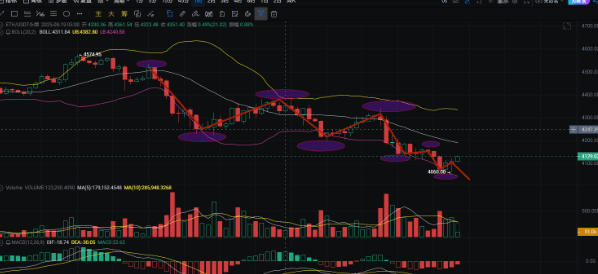On the absurd stage of the cryptocurrency market, which has no script, things may seem chaotic and disordered, but there are hidden truths. Smart people can always see through the surface to the essence. The waterfall-like drop of ETH last night made many investors exclaim that “the wolf is coming,” but the truth is not as simple as it appears. This is both a necessary technical adjustment and a strong signal of institutional capital moving in the background.
Last night’s sharp decline: unexpected yet reasonable
Last night’s ETH trend was a classic case of technical analysis. In the afternoon, there was a pullback, and before the opening of U.S. stocks, the price surged to $4,340, only to plummet down to $4,064 like sliding down a slide. This drop was not a random market fluctuation but a warning that key technical indicators had already issued. The 30-minute RSI fell to the oversold zone of 22.7, suggesting that the short-term decline may rebound, but the 4-hour MACD remains in a bearish divergence state, with downward pressure not fully released. More importantly, the timing of the rebound coincided with the “liquidity trap” period before the U.S. stock market opened, where institutional capital took advantage of retail investors chasing high to sell off heavily, driving the price down.
This is like encountering a seemingly attractive discount store while shopping, only to find out that it's a tactic of "clearance sales," and the owner has already calculated that customers would take the bait. Last night's movement of ETH was precisely a "technical trap" carefully set by institutions for retail investors.
Institutional Capital: The Hidden Manipulation Behind the Collapse
Despite the significant price drop, institutional capital has been secretly “bottom-fishing.” Data clearly shows that the net inflow into Ethereum ETFs reached $2.9 billion in a single week, accounting for 80% of total inflows into crypto ETFs, with cumulative inflows in August surpassing $11 billion. This means an average of $160 million in “smart money” is flowing into the ETH market every day.
However, why is the price still continuously dropping? The derivatives market plays an important role in this. The open interest in futures reached a new high of $60.8 billion, with nearly 90% of long positions being liquidated, resulting in many leveraged traders being “blood washed” in this wave. Institutional capital took this opportunity to accumulate a large amount at low levels, absorbing the chips from retail investors.
The absurd drama of the cryptocurrency market continues to unfold, and the sharp decline of ETH is just one exciting scene in it. For investors, to win in this war without gunpowder, one must learn to read the underlying messages of the market like a smart person, not be misled by the apparent chaos, and gain insight into the movements of institutional capital in order to navigate steadily through the waves of the cryptocurrency market.

Analysis Highlights
Clear Range Division
Specific range predictions for price movements during the day and night are provided. For example, during the day, the price may first pull back to the $4,150 - $4,180 range or drop to around $4,064 before rebounding, and at night, the range for rebounding or downward probing will be judged based on the performance after the opening of U.S. stocks, enabling investors to have a more intuitive understanding of the price fluctuation range under different conditions.
Key Price Level Identification
Identified the key price level of $4,064 as the “line of life and death,” emphasizing its important support role for price trends. Falling below this price level may trigger a significant price drop, providing investors with important risk warnings and decision-making references.
Clear Condition Judgments
In the evening segment's predictions, the conditions based on the performance after the opening of U.S. stocks and whether it can hold above $4,064 and recover to $4,200 clearly delineate two different trend scenarios, allowing investors to adjust their investment strategies in a timely manner based on actual market performance.
Possible Risks and Shortcomings
Market Uncertainty
Although predictions are based on technical analysis and market sentiment, the market is influenced by numerous complex factors such as macroeconomic data, policy changes, and sudden events. These factors can lead to significant deviations between actual trends and predictions. For instance, sudden major international political events may trigger sharp market fluctuations, completely altering originally predicted daytime pullbacks or rebound trends.
Limitations of Technical Analysis
Technical analysis is a method based on historical prices and trading volumes. While it can reveal certain market patterns, it cannot accurately predict future price movements. Market sentiment and investor behavior can change at any time, causing technical indicators to fail. For example, during panic selling or buying, prices may break through the support and resistance levels predicted by technical analysis.
Lack of Time Dimension
The analysis mainly focuses on price range predictions but does not mention how long each range trend may last. Investors, when formulating trading strategies, need to consider not only the price ranges that may be reached but also the time factor to arrange capital and trading rhythm reasonably.
Improvement Suggestions
Increase Risk Factor Analysis
Mention major risk factors that could affect market trends in the analysis, and briefly explain their potential impact on price movements. For example, it can be pointed out that if key economic data released on that day falls short of expectations, it may negatively affect market sentiment and lead to price declines.
Combine Various Analytical Methods
In addition to technical analysis, fundamental analysis can also be combined, such as the fundamentals of related assets and industry development trends, to improve the accuracy of predictions. For example, if the industry to which the analyzed asset belongs is in a rapid development stage with good fundamentals, then even if technical signals indicate a pullback in the short term, the price may still rise in the long term.
Supplement Time Dimension Information
Provide rough estimates of how long each price range trend may last, or indicate key events and market signals that need to be monitored at different time points. For example, it can be pointed out that during the daytime trading period, a specific time point may have important data released, which could affect price trends, and investors need to pay close attention.
Short-term: Adopt a "quick in and out" strategy.
Long-term: Adopt a "buy on dips" strategy.
Short-term Trading Strategy
Short Position Strategy: When the price rebounds to the $4,150 - $4,200 range, consider shorting, with a stop loss set at $4,250 and a target price below $4,050.
Long Position Strategy: If the price stabilizes in the $4,064 - $4,080 range, consider a long position, with a stop loss set at $3,990 and a target price above $4,180.
Key Points of Risk Control
Risk control is the "lifeline" of trading and must strictly adhere to the principle that the risk of each trade does not exceed 2-3% of the principal. At the same time, be cautious of the amplified volatility effect at the opening of U.S. stocks in the evening, closely monitor expectations of Federal Reserve policy and the movement of the U.S. dollar index.
Market Insights
The cryptocurrency market is by no means a “get rich quick” casino, but a battlefield for “cognitive monetization.” Taking ETH as an example, the sharp drop last night was actually a “reshuffling” by institutions, and also a timing for smart investors to “position.” As analyst James Seyffart stated: “The continuous net inflow of funds into Ethereum ETFs clearly indicates that institutions have regarded it as a ‘core digital asset’ for strategic allocation.”
Currently, the price of ETH hovers around $4,100, but the real market competition has just begun. After the opening of U.S. stocks tonight, the direction of institutional capital flows and overall macro sentiment will be key factors in determining the next critical direction of ETH. In the face of a complex and volatile market, will you let market sentiment dictate your actions, or will you remain calm, analyze deeply, and seize potential opportunities?
BTC BTH PEPE


